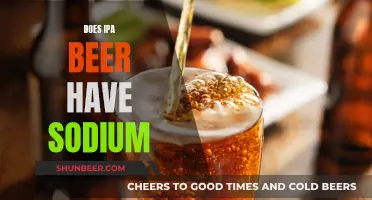
India Pale Ales, or IPAs, are known for their bitter taste. The bitterness in IPAs is primarily attributed to the use of hops, the flower of a female plant called Humulus lupulus, which is a crucial ingredient in the brewing process. Hops counteract the sweetness of malt grain, and the amount and variety of hops used can significantly influence the bitterness level of the beer. International bitterness units (IBUs) are used to measure bitterness in beer, with lower IBUs indicating less bitterness and anything over 45 IBUs considered more bitter. While bitterness is a defining characteristic of IPAs, other factors, such as the addition of fruits, herbs, and vegetables, also contribute to the complex flavor profile of these popular craft beers.
What You'll Learn

Hops and the IPA brewing process
Hops are a key ingredient in the IPA brewing process, and the type and amount of hops used can significantly impact the flavour and bitterness of the beer.
The IPA, or India Pale Ale, is well-known for its use of hops, which can add bitterness, aroma, and flavour to the beer. Brewers have a wide range of hops varieties to choose from, each with its own unique characteristics. Some popular hops used in IPAs include Citra, Simcoe, Mosaic, Galaxy, and Centennial. Brewers can also use a single type of hop or a combination of different hops to create their desired flavour profile.
When brewing an IPA, the timing of hop additions is crucial. Adding hops at different stages of the brewing process can affect the level of bitterness, flavour, and aroma in the final product. For example, a technique called hop bursting involves adding a generous amount of hops during the final 15 minutes of the boil, which can introduce intense hop flavour and aroma without increasing bitterness.
Another important consideration is the amount of hops used. While more hops generally result in a more bitter beer, brewers must be careful not to overuse hops, as this can lead to an overly bitter taste that may be unpleasant for drinkers. Finding the right balance between bitterness and other flavour components is essential for creating a well-rounded and enjoyable IPA.
The IPA style has also evolved to include variations such as the West Coast IPA, New England IPA, and hazy IPA, each with its own unique characteristics and hop profiles. These styles may have different levels of bitterness, malt profiles, and fruit flavours, showcasing the versatility of IPAs.
In conclusion, the IPA brewing process is heavily influenced by the type, amount, and timing of hop additions. Brewers carefully select and combine different hops to create distinct flavours, aromas, and bitterness levels, contributing to the popularity and diversity of IPAs.
Beer, Sangria, and IPAs: What's the Difference?
You may want to see also

IBUs and the popularity of the IPA
IBUs, or International Bitterness Units, are a scale used to measure the bitterness of a beer. The scale ranges from 0 to 120, with most beers falling between 5 and 80 IBUs. While IBUs are a good indicator of how bitter a beer will taste, they don't tell the whole story. The perceived bitterness of a beer can be very different from its IBU rating, as the alcohol content, malt profile, and residual sugars can also affect how bitter a beer tastes.
IPAs, or India Pale Ales, are known for their strong, bitter flavor. The bitterness in IPAs comes from the high amount of hops used in brewing. While some people love the bracing bitterness of an IPA, others find it unbearable. However, it's important to note that bitterness in beer is not necessarily a bad thing. It can provide a refreshing balance to the other flavors in the beer.
The popularity of IPAs can be attributed to a few factors. First, they are considered "advanced" beers. Unlike sweeter beers, humans are not pre-wired to like IPAs. It takes time and exposure to develop a taste for their bitterness. As a result, ordering an IPA can be seen as a badge of honor for craft beer enthusiasts.
Secondly, IPAs have a lot of flavors. When you drink an IPA, your taste buds detect sweetness and bitterness, but when paired with the aroma and golden color, you sense flavors like grapefruit, pine, and roses. Each drinker's personal taste is unique, so not everyone will like the same IPA.
Finally, IPAs are constantly evolving. Brewers are always experimenting with new variations, such as hazy IPAs, which have a higher bitterness level, a dialled-down mouthfeel, and a fuller body. These regional variations keep the style interesting and allow drinkers to explore a wide range of options.
The Mystery of IPA Beer Dust: What Is It?
You may want to see also

Perceived bitterness
The bitterness of an IPA is largely determined by the brewing process and ingredient profile. The ingredient profile includes hops, fruits, herbs, and vegetables. The amount of hops added, the timing of the addition, and the type of hops used all influence the bitterness level of the final product. Hops are a crucial ingredient in counteracting the sweetness of malt grain, and they have been used in beer brewing since 822 AD. Today, brewers have a wide range of hop varieties to choose from, each contributing distinct flavours and bitterness levels to the beer.
The perception of bitterness in IPAs is a complex and highly subjective experience. The "perceived bitterness" of a beer is influenced by factors such as alcohol content, malt profile, and residual sugars/attenuation. For example, an imperial stout with 85 IBUs may not taste bitter at all due to the balancing effect of its sweetness. This complexity in bitterness perception highlights the multifaceted nature of tasting beer.
International Bitterness Units (IBUs) are a metric used to quantify the bitterness of a beer, typically ranging from 1 to 100, with anything above 45 IBUs considered more bitter. However, IBUs do not always align perfectly with perceived bitterness, as the Beer Judge Certification Program (BJCP) and the Brewers Association (BA) acknowledge in their guidelines. These organisations emphasise that the impression of bitterness can vary significantly from the measured IBU levels.
The evolution of the IPA style showcases the dynamic nature of beer preferences. While West Coast IPAs are known for their pine resin flavour, New England-style IPAs offer a fruit-forward alternative. The New England IPAs tend to be sweeter or thicker, while West Coast IPAs proudly showcase their IBUs and crisp malt bills. This variety within the IPA style allows drinkers to explore and discover their preferred balance of bitterness and other flavour profiles.
The perception of bitterness in IPAs can also change over time as drinkers' tastes evolve. While someone may not enjoy the bitterness of their first IPA, they may develop an appreciation for it over subsequent tastings. This evolution of taste highlights the interplay between individual perception and the unique flavours of IPAs.
Explore the Truth: IPA and Its Dark Beer Mystery
You may want to see also

The evolution of the IPA style
The India Pale Ale (IPA) has evolved significantly over its 200-year history. The style emerged in the mid-1700s when the British Empire ruled vast territories worldwide. To prevent beer from spoiling during its long sea voyages to India, brewers fortified it with high alcohol content and heavy hops. These early IPAs were likely "pale ales prepared for India" and were often porters.
In the 19th century, George Hodgson of London's Bow Brewery created a well-known example of the IPA style, known as October Ale, which was popular among British occupants in India. The term "India Pale Ale" was first used in 1829 in an Australian newspaper advertisement.
During the late 19th and early 20th centuries, the IPA style remained relatively unchanged. However, with the emergence of the American brewing industry, lagers were the predominant style, and only a few early IPAs, such as Ballantine IPA, were produced.
In the 1970s, the IPA style evolved with the introduction of American ingredients, particularly Cascade hops, which added a grapefruity flavour. This led to the creation of the West Coast IPA style, characterised by increased bitterness, piney and aromatic qualities.
The 1990s saw the release of more aromatic American hop varieties, such as Chinook, Centennial, and Columbus, which brewers incorporated into IPAs, resulting in bolder flavours and aromas.
In the 2000s, the West Coast IPA style continued to evolve, with breweries competing to create IPAs with higher International Bitterness Units (IBUs). New hop varieties, such as Simcoe®, Amarillo®, and Citra®, were introduced, focusing on fruity aromas.
The 2010s witnessed the rise of the New England IPA (also known as Hazy IPA) , pioneered by Alchemist's Heady Topper. These IPAs emphasised drinkability, fruit-forward hop aromas, and a cloudy, juice-like appearance. Brewers reduced bitterness and emphasised softness in the finish.
The present-day IPA has further evolved into the Milkshake IPA, characterised by the addition of lactose or maltodextrin, resulting in a rounded mouthfeel and subtle sweetness. This style often includes fruit and vanilla to complement the fruity flavours of the hops.
Stout and IPA: What's the Difference?
You may want to see also

How to get past the bitterness
The bitterness of an IPA is influenced by a variety of factors, including the type of hops used, the brewing process, and the presence of other ingredients that can balance out or accentuate the bitterness. While some people enjoy the bitter taste of IPAs, others may find it too intense or unpleasant. If you fall into the latter category, here are some tips to help you get past the bitterness and enjoy your beer:
- Explore different types of IPAs: Not all IPAs are created equal. West Coast-style IPAs tend to be more bitter, while New England-style or hazy IPAs are known for their fruit-forward flavours and softer bitterness. Try exploring different varieties to find one that suits your palate.
- Pair it with food: Food can help balance out the bitterness of an IPA. Try pairing your beer with spicy dishes, salty snacks, or sweet desserts to enhance your drinking experience.
- Serve it at the right temperature: Serving temperature can impact the perceived bitterness of an IPA. Instead of drinking it ice-cold, let it warm up slightly to enhance the fruity aromatics and reduce the bitterness.
- Try a different style of beer: If you find that you still don't enjoy IPAs despite your efforts, don't force yourself to drink them. Explore other styles of beer, such as Belgian tripels, stouts, or pale ales, to find one that suits your taste preferences.
- Adjust your palate gradually: If you're new to IPAs, start with a milder version and gradually work your way up to the more bitter varieties. Over time, your palate will adjust, and you may find that you develop a taste for the bitterness.
- Add a twist: Consider adding a twist of citrus, such as a slice of orange or grapefruit, to your IPA. The fruit can help to balance out the bitterness and add a refreshing touch to your drink.
- Explore different brands: Not all IPAs are brewed the same. Different breweries use varying techniques and ingredients, resulting in unique flavour profiles. Experiment with different brands to find one that suits your taste.
- Check the freshness: Freshness is crucial when it comes to IPAs. Older IPAs may taste more bitter or have an unpleasant aftertaste. Look for freshness dates or enjoy your IPA as close to the bottling or canning date as possible.
Remember, the key to enjoying beer is to find what works for your taste buds. Don't be afraid to step out of your comfort zone and try new varieties, but also don't force yourself to like something that doesn't suit your palate. With the wide range of beer styles and brands available, you're sure to find one that you can savour and appreciate.
Estrogen in IPAs: Myth or Reality?
You may want to see also
Frequently asked questions
The use of hops in the brewing process is what makes an IPA bitter. Hops are flowers from the female plant called Humulus lupulus and counteract the sweetness of malt grain.
Hops are flowers from the female plant called Humulus lupulus and are a crucial ingredient in beer. They have been added to beer since 822 AD.
All beers are made with hops, but not all beers are hoppy or bitter in flavour. A hoppy beer means you can taste the flavours of the hops used, whereas a bitter beer will have a more evident, bracing, and aggressive bitterness.
International Bitterness Units (IBU) are a metric unit that measures the bitterness of a beer. The IBU measurement scale is generally between 1 and 100, with anything over 45 IBUs considered more bitter.
Bitterness in beer provides a refreshing balance. People learn to like IPAs over time, and it can be a badge of honour to order one.







